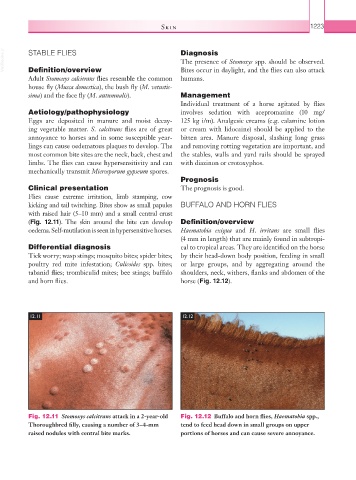Page 1248 - Equine Clinical Medicine, Surgery and Reproduction, 2nd Edition
P. 1248
Skin 1223
VetBooks.ir STABLE FLIES Diagnosis
The presence of Stomoxys spp. should be observed.
Definition/overview
Adult Stomoxys calcitrans flies resemble the common Bites occur in daylight, and the flies can also attack
humans.
house fly (Musca domestica), the bush fly (M. vetustis-
sima) and the face fly (M. autumnalis). Management
Individual treatment of a horse agitated by flies
Aetiology/pathophysiology involves sedation with acepromazine (10 mg/
Eggs are deposited in manure and moist decay- 125 kg i/m). Analgesic creams (e.g. calamine lotion
ing vegetable matter. S. calcitrans flies are of great or cream with lidocaine) should be applied to the
annoyance to horses and in some susceptible year- bitten area. Manure disposal, slashing long grass
lings can cause oedematous plaques to develop. The and removing rotting vegetation are important, and
most common bite sites are the neck, back, chest and the stables, walls and yard rails should be sprayed
limbs. The flies can cause hypersensitivity and can with diazinon or crotoxyphos.
mechanically transmit Microsporum gypseum spores.
Prognosis
Clinical presentation The prognosis is good.
Flies cause extreme irritation, limb stamping, cow
kicking and tail twitching. Bites show as small papules BUFFALO AND HORN FLIES
with raised hair (5–10 mm) and a small central crust
(Fig. 12.11). The skin around the bite can develop Definition/overview
oedema. Self-mutilation is seen in hypersensitive horses. Haematobia exigua and H. irritans are small flies
(4 mm in length) that are mainly found in subtropi-
Differential diagnosis cal to tropical areas. They are identified on the horse
Tick worry; wasp stings; mosquito bites; spider bites; by their head-down body position, feeding in small
poultry red mite infestation; Culicoides spp. bites; or large groups, and by aggregating around the
tabanid flies; trombiculid mites; bee stings; buffalo shoulders, neck, withers, flanks and abdomen of the
and horn flies. horse (Fig. 12.12).
12.11 12.12
Fig. 12.11 Stomoxys calcitrans attack in a 2-year-old Fig. 12.12 Buffalo and horn flies, Haematobia spp.,
Thoroughbred filly, causing a number of 3–4-mm tend to feed head down in small groups on upper
raised nodules with central bite marks. portions of horses and can cause severe annoyance.

